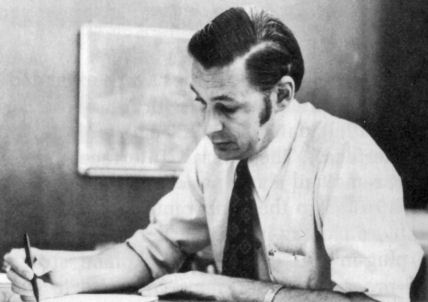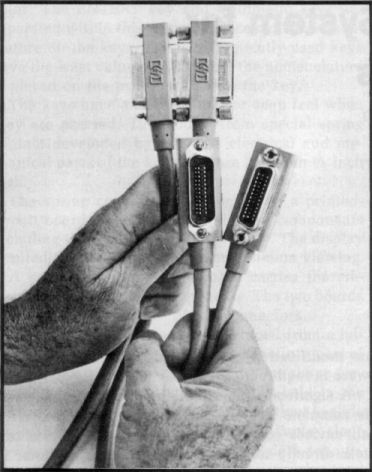|
The year 1972 was truly momentous for the HP Loveland Calculator Division. The second and third of the second-generation desktop calculators (the HP 9820A and HP 9830A) appeared that year. Another major event, not directly tied to the Loveland Calculator Division, was the introduction of the Hewlett-Packard Interface Bus (HPIB). The October, 1972 issue of the HP Journal carried two articles that discussed the operation of the HPIB. The first article was a technical piece written by two of the people who were responsible for the HPIB’s development: Gerry Nelson and Dave Ricci. The second article was a sort of history lesson on interfacing to instruments written by Don Loughry, who held the position of “corporate interface engineer” back in 1972.
|

|
|
Don Loughry. Photo courtesy of the Hewlett-Packard Company
|
|
|
|
Gerry Nelson. Photo courtesy of the Hewlett-Packard Company
|
|
|
|
Dave Ricci. Photo courtesy of the Hewlett-Packard Company
|
|
The HPIB created a solution to one of HP’s big problems. The company had been founded in 1939 to build stand-alone instruments. All of these instruments were designed to be operated manually. The instruments of the day were analog, not digital, and there were no computers capable of operating test and measurement equipment at the time, so there was no need for any sort of interfacing ability. A lot changed in the next two decades.
One of the biggest changes was the US Government getting into the business of developing and testing nuclear weapons. This work required the development of sophisticated instrumentation systems to make measurements of nuclear tests. HP got a lot of instrumentation business from this research. At the same time, the US started to ramp up other parts of the military/industrial complex to develop advanced aircraft, missile systems, submarines, radar systems, and communications systems (and a lot more). All of this work also required increasingly sophisticated test and measurement systems and HP was in the thick of this work.
The first instrumentation systems
It was during this period of the late 1950s that HP created Dymec to integrate HP instrumentation into test and measurement systems and to develop specialized pieces of equipment for these systems when no standard instrument existed. Don Loughry became Dymec’s engineering manager in 1963.
HP’s systems work led to the development of programmable instruments in many of the company’s divisions. The first of these programmable instruments were controlled by simple switch or relay closures because very little electrical engineering was needed to route critical circuit nodes inside of the instrument to back-panel terminals so that remote switches and relay contacts could be attached. Power supplies often had these sorts of simple terminals on the back so that their output voltages could be remotely set. Naturally, there was no standardization at this point.
The late 1950s also saw the introduction of the first digital instruments such as frequency counters, digital voltmeters, and digital recorders (a printer with an instrument interface, still no computers in sight). Loughry wrote that the “Adam and Eve” of instrumentation systems was a frequency counter coupled to a digital recorder and that these early test and measurement systems were highly successful. So successful in fact that it took only five more years for digital interfaces to sprout on many HP instruments including digital voltmeters, scanners, power supplies, and remote displays.
Interfacing Babel
Naturally, every instrument presented unique interfacing requirements because the instruments were developed at various HP divisions with different project goals, which increased system-integration costs. Dymec got into the business of developing system controllers to ease the creation and integration of test and measurement systems, which naturally led first to the evaluation of Digital Equipment Corporation minicomputers as system controllers and ultimately to the development of the HP 2116A instrumentation computer.
By the mid 1960s, HP divisions had created a real instrumentation tower of Babel and many engineers in the company’s various divisions realized that the company sorely needed a more standardized way of hooking various instruments together. Instruments sported all sorts of incompatible interfaces such as the switch-closure control terminals described above, many flavors of binary and binary-coded decimal (BCD) interfaces, serial current-loop interfaces (like the ubiquitous ASR-33 Teletype teleprinter), and the relatively new RS-232 serial interface. A standardized interfacing method also would need to bring controllers and computers into the fold because they were fast becoming the core of a new and highly profitable HP business: automated test systems.
One of the first successful attempts to unify this chaotic interfacing world was the HP 2570A instrumentation coupler, developed by Geoff Chance and Bob Tinnen in the Loveland Instrument Division and then transferred to the Dymec Division. By 1970, when the HP 2570A was introduced, the Dymec Division had become the Automatic Measurement Division.
Corporate interfacing criteria
The HP 2570A was a stop-gap measure, intended to deal with the situation as it was (an interfacing Babel) and not as the Hewlett-Packard Company wished it to be. HP reduced the requirements for a universal instrumentation interfacing standard to these four:
- Capable of interconnecting small, low-cost instruments systems by means of simple passive cable assemblies without restricting individual instrument performance and cost.
- Capable of interconnecting a wide range of products (measurement, stimulus, display, processor, storage) needed to solve real problems.
- Capable of operating where control and management of the message flow over the interface is not limited to one device but can be delegated in an orderly manner among several (multi-master operation).
- Capable of interfacing easily with other more specialized interface environments.
|

|
|
HPIB cables could be stacked, which made it easy to create both daisy-chained and star-shaped network topologies. Photo courtesy of the Hewlett-Packard Company.
|
|
The system ultimately chosen to fulfill these requirements was dubbed the “Hewlett-Packard Interface Bus” or HPIB. A wide, parallel interface was deemed to costly, cumbersome, and impractical in terms of requiring stiff, fat cables carrying far too many wires. A narrow bit-serial interface such as the current-loop and RS-232 interfaces could have served if the data rate was high enough, but there was insufficient semiconductor technology at the time to support such a complex interface. From a 21st-century perspective, it’s very hard to understand this constraint when we have 100-Mbit and gigabit serial interfaces in every office running over what is essentially pedigreed telephone wires, but integrated circuits were only 10 years old back then and you couldn’t even buy a simple serial UART (a serial chip for relatively slow RS-232 communications) on one IC. Therefore, the HPIB employed a compromise scheme of bit-parallel, byte-serial communications.
HPIB cables carried one byte at a time over a cable consisting of 15 signal wires (plus a ground wire and shield). The double connectors on each end of the HPIB cables allowed the cables to be stacked, which made it easy to create both daisy-chained and star-shaped network topologies. Either topology worked. The choice of a 16-wire cable minimized cable, connector, and support-circuit costs and therefore represented an excellent compromise.
HPIB was introduced to the world in 1972 and over the next several years, HP’s older instruments were phased out and replacements sported HPIB interfaces. Thus, by the mid 1970s when the third-generation HP desktop calculators started to appear, the instrumentation side of the company had built a huge army of instruments ready to be commanded by a competent interfacing controller.
That would be the HP 9825.
References:
Gerald E. Nelson and David W. Ricci, “A Practical Interface System for Electronic Instruments,” HP Journal, October 1972, p 2-7.
Donald C. Loughry, “A Common Digital Interface for Programmable Instruments: The Evolution of a System,” HP Journal, October, 1972, p 8-11.
|